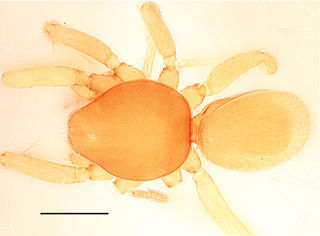
Scaffold web spiders (Nesticidae) is a family of araneomorph spiders closely allied with tangle web spiders. Like the "Theridiidae", these spiders have a comb of serrated bristles on the hind tarsi that are used to pull silk bands from the spinnerets. It contains 16 genera and about 300 species, many of which are associated with caves or overhangs. The genus Nesticus is the type for the family and is found throughout the world. The related Eidmannella has speciated considerably in Texas caves and includes some extremely localized species that are considered threatened. One species, Eidmannella pallida, is found in caves and under overhangs, but also in agricultural fields and other habitats away from such restricted areas. The genus Carpathonesticus is found in central Eurasia.

Bannana is a genus of goblin spiders native to Xishuangbanna prefecture, Yunnan Province, China, where it lives in the leaf-litter of tropical rainforest. There are two known species: Bannana crassispina and B. parvula, both described in 2015. Individuals are pale yellow and unpatterned, and range from around 1.0 to 1.8 mm in body length, with females being slightly larger than males. The eyes are reduced or entirely absent. Known only from a nature reserve in Xishuangbanna, Bannana belongs to a group of Asian goblin spiders known as the "Dysderoides complex", that ranges from China to Pakistan and south to Indonesia.
Aituaria is a genus of spiders in the family Nesticidae. It was first described in 1998 by Esyunin & Efimik. As of 2016, it contains two species, Aituaria nataliae and Aituaria pontica, the latter of which was transferred from Nesticus first to Carpathonesticus, then to Aituaria.
Carpathonesticus avrigensis is a species of araneomorph spider of the family Nesticidae. It occurs in Romania, where it was discovered in a cave. Only two specimens, a male and a female, are known.
Carpathonesticus borutzkyi is a species of araneomorph spider of the family Nesticidae. It occurs in Russia, Georgia, Turkey and Ukraine and is found in caves.
Carpathonesticus cibiniensis is an araneomorph spider species of the family Nesticidae. It occurs in Romania, where it can be found in the cellars of old houses.
Carpathonesticus fodinarum is a species of araneomorph spider of the family Nesticidae. It occurs in Romania, where it occurs in caves.
Carpathonesticus hungaricus is a species of araneomorph spider of the family Nesticidae. It occurs in Romania, where it inhabits caves.
Carpathonesticus ljovuschkini is a species of araneomorph spider of the family Nesticidae. It occurs in the Russian Caucasus. No male specimens have yet been described.
Carpathonesticus lotriensis is an araneomorph spider species of the family Nesticidae. It occurs in Romania, where it can be found in caves.
Carpathonesticus mamajevae is an araneomorph spider species of the family Nesticidae. It occurs in Georgia, in the Lagodekhi Nature Reserve.
Domitius menozzii is an araneomorph spider species of the family Nesticidae. It occurs in Italy, where it can be found in caves. It was described by Ludovico di Caporiacco in 1934.
Carpathonesticus paraavrigensis is a species of araneomorph spider of the family Nesticidae. It occurs in Romania, where it was discovered in a narrow gorge, on the overhanging side.
Carpathonesticus puteorum is a species of araneomorph spider of the family Nesticidae. It is found in the Romanian caves at an altitude of 460 to 930 m.
Carpathonesticus parvus is a species of araneomorph spider of the family Nesticidae. It occurs in Bosnia-Hercegovina, where it is found in caves. It was originally described from a single female specimen.
Carpathonesticus simoni is an araneomorph spider species of the family Nesticidae. It occurs in Romania, where it can be found in caves. It was transferred from the genus Nesticus to Carpathonesticus in 1980 by Lehtinen and Saaristo.
Carpathonesticus spelaeus is an araneomorph spider species of the family Nesticidae. It occurs in Romania, where it can be found in caves and outdoors under calcareous blocks. It was transferred from the genus Nesticus to Carpathonesticus in 1980 by Lehtinen and Saaristo.
Carpathonesticus zaitzevi is an araneomorph spider species of the family Nesticidae that occurs in Georgia. It was transferred from the genus Nesticus to Carpathonesticus in 1996.
Diminutella is a genus of spiders in the family Sparassidae. It was first described in 2018 by Rheims and Alayón. It is a monotypic genus with one described species, Diminutella cortina. It is endemic to Pinar del Rio, Cuba.

